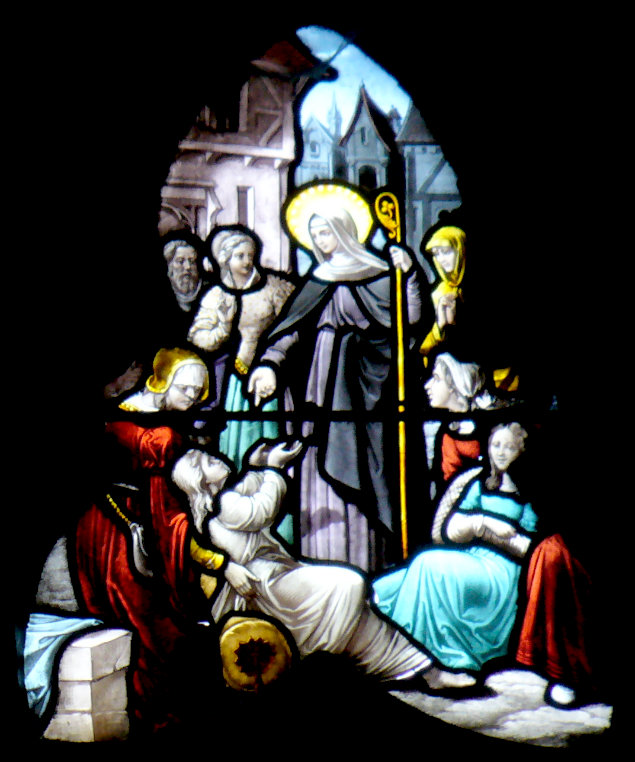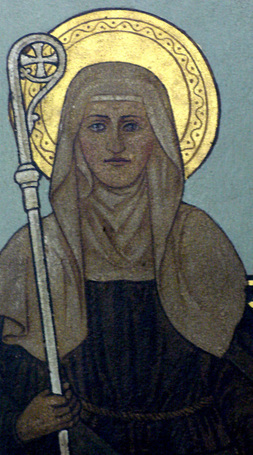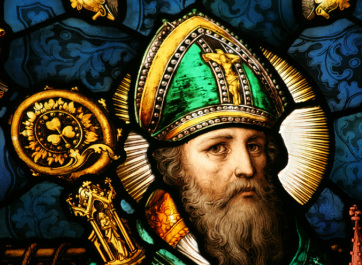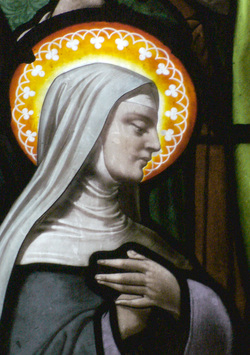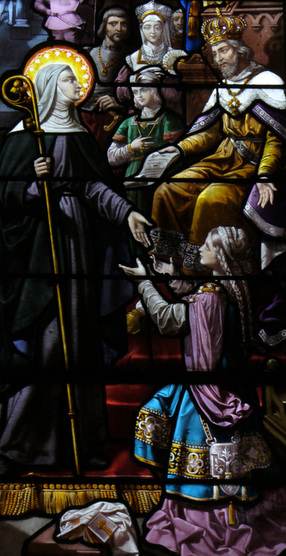St ModwenVisitors to Burton and to the parish find Modwen (or Modwenna as she is also known as) an unusual name, a saint that they have never heard of before. It is only natural to want to know more about her.
Geoffrey of Burton became Abbot of a Benedictine monastery here in Burton in 1114. Previously, he was Prior at Winchester. In his new position as Abbot and in his new home, Geoffrey, together with the community, was the guardian of the shrine and relics of St Modwen. Naturally, he wanted to know more about his saint so set about writing a history of the life and miracles of St Modwen.
Abbot Geoffrey's life of St Modwen survives to this day and has been translated into English by Prof. Robert Bartlett. This document, together with other small sources of information is the only pre-reformation link to the life of St Modwen.
|
There was in the island of Ireland a virgin named Modwenna...
|
Modwen was a beautiful woman who was born among the Conaille. Her father was King Mochta, her mother, Cumman. She was born into a noble and wealthy family.
St Patrick was sent by Pope Celestine to Ireland to preach the Good News in the 5th Century. St Patrick preached all over Ireland and drew many to people away from pagan practices to the Christian faith. He taught the crowds that every person has a vocation. Modwen was very moved by the saintly bishop's words and enthusiasm. As soon as Patrick had finished one talk she went to him and prostrated herself before him and said that she wanted to dedicate herself to God. She insisted, with tears, that she be clothed with a habit and that, "with Christ's the Lord was her companion, she could serve without any regret until the day of her death, through His grace." |
|
Modwen was joined by one of her relatives, Athea. Together, they were told by St Patrick to learn the Psalms and to read and write.
Modwen's life and growing holiness was an inspiration, especially to her family. Her father turned away from a life of crime, her mother sought a more holy way of life. Her brother became a priest and later, a bishop. After the death of her parents, Modwen spent some time living on the Aran Isles living with the hermit Bishop Iber and his followers. 'Modwenna lived there like a prudent bee'During her time with the community on the Aran Isles, Modwen learned many things about the religious life. Abbot Geoffrey tells us that she sucked up the good habits of behaviour like a bee taking good things from each flower.
|
|
St Modwen set up her first monastery in a remote spot on Mount Faughart. There, she lived with her brother and sister. They lived on a diet of raw roots, prayed continually and set a good example to the local people. The community was small at first, only eight nuns. Very quickly that grew to a hundred and fifty. Many people visited the monastery where Modwen instructed them to avoid evil especially, killing, drunkenness, plundering and to abandon magic.
About this time, Alfrid son of the King of England came to Ireland...The illegitimate son of Oswy fled to Ireland when Egfrid became king. The Irish king, at that time, was Finnachta who reigned until 695. The Irish king wished to give Alfrid a gift on his return to England instructed his men to rob a church or convent, as he had nothing himself, at present the treasures to the prince. It was Modwen's church and monastery that was pillaged.
Modwen must have been a formidable person. She immediately set sail for England and demanded, from Prince Alfrid in Northumbria, all the things that were taken from the monastery. Alfrid, who was now king, promised to repay Modwen for everything that was taken. They met in Whitby in 685 and Modwen was invited to stay at the double monastery founded by St Hilda in 658. The king's sister Elfleda was at the monastery and was entrusted to Modwen for instruction. In time, Elfleda became the second Abbess, after St Hilda. |
St Modwen returns to IrelandAfter her time at the monastery of Whitby, Modwen returned to Ireland to visit the foundations she had made there. Sometime later, she made a pilgrimage to Rome. During this pilgrimage she passed through Burton-Upon-Trent.
|
St Edith...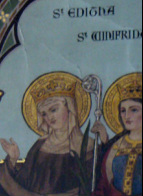
One of the saints depicted on the walls of the sanctuary is St Edith of Polesworth. It has been suggested in some accounts of the life of St Modwen, that king Alfrid of Northumbria and king Alfred the Great were the same person. Alfred the Great's sister was St Edith. It is easy to see how a confusion may have arisen between these two kings. St Edith died in 954, a number of centuries after St Modwen. Although the image of this local saint is depicted on the sanctuary walls, it impossible that Edith and Modwen crossed paths in this life.
|

